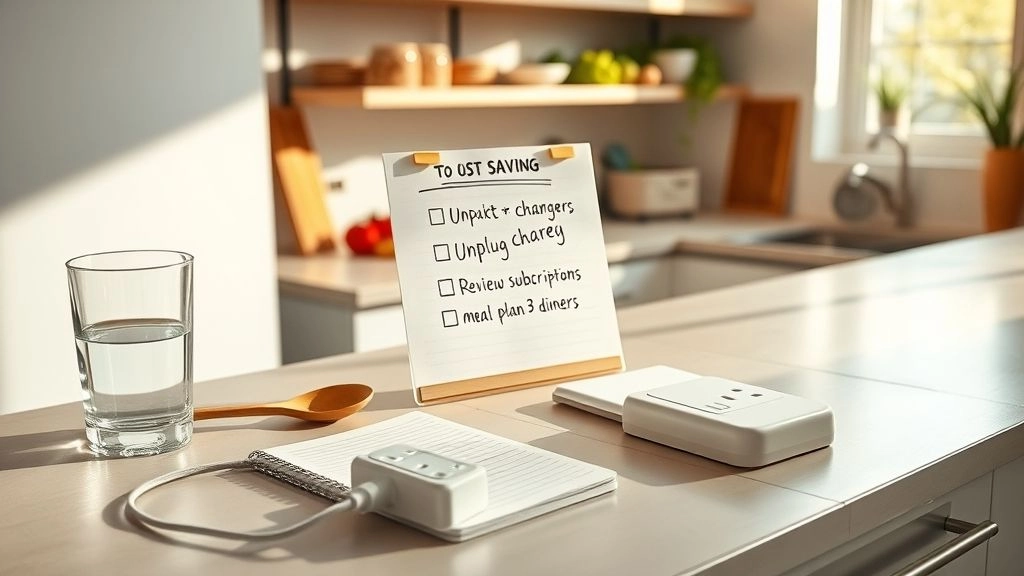Wait, Do Tiny Tweaks Really Matter?
Ever find yourself tossing loose change in a jar, thinking, “This’ll never add up to anything”? Yeah… me too. But hold up. That little coin mountain can turn into the pizza delivery fund, movie night, or heck, a mini-vacation if you’re patient. That, right there, is the soul of cost-saving kaizen ideas—powerful change, but gentle, almost sneaky. Small moves, relentless improvement. Suddenly, your piggy bank’s training for a marathon.
I’m not here to hand you a snooze-worthy lecture on “what is kaizen” or slap you with budgeting charts that belong in some accountant’s hall of fame. We’re talking real life, real mess, real wins. Because if a factory worker can save a company millions just by shifting how they heat stuff up (true story—more on that later), you and I can absolutely crush our own little money leaks. No need for spreadsheets if that’s not your thing… (I won’t tell anyone if you do the crumpled up receipt shuffle, promise.)
Why Do These Little Changes Work?
Big Overhauls = Burnout. Small Steps? Game On.
Let’s get this out in the open: Huge budgeting “life overhauls” usually last as long as my New Year’s workout streak (read: two weeks and one pulled hamstring). Kaizen’s magic? It doesn’t bully you. It’s more like a nudge—”Hey, what if you brought lunch just once this week instead of eating out?” or “Could you flick off that power strip before bed?”
It’s the opposite of those crash diets. Instead of all-or-nothing, it’s… all-or-a-bit-better-today. And science backs it up. If you’ve ever read about simple cost-saving ideas for companies, you’ll see even big organizations save serious cash from the tiniest tweaks—like turning off unused machines or reviewing subscriptions monthly. Why shouldn’t that work for us regular folks?
Can We Really Save Money Without Feeling Miserable?
Short answer: Yes. Why? Because you’re not cutting back on everything at once (that’s a fast track to “screw it!” takeout). You just adjust. One step, one habit, one bill at a time. You barely notice—until you do. And your savings? Suddenly, they’re giving side-eye to your last credit card bill.
Everyday “Tiny Wins” that Add Up Fast
Who’s Stealing Your Cash (And You Had No Idea)?
Sometimes, it’s not the big bills. It’s the sneaky stuff. Think: the $9.99 streaming app that auto-renews but you only watched once (for that one show that, let’s face it, was just “meh”). Or, leaving chargers, toasters, and old TVs plugged in 24/7—those energy vampires! In manufacturing, Kaizen fans run “waste walks” to spot everything that eats away at profits… you can totally steal that move at home. (Zero hard hats required.)
Power-Saving: Is It Worth the Fuss?
I tried it last winter—unplugged everything I could before work, switched to LEDs, and yes, got passive-aggressive with the thermostat. Result? My utility bill dropped by around 17%. No joke! If you want pro inspiration, in the business world, this is exactly how kaizen cost reduction happens: machines are powered down when not in use, tech like motion sensors steps in, and suddenly, the meter spins slower.
| Habit | Before Kaizen | After Kaizen | Yearly Savings |
|---|---|---|---|
| Leaving lights on | Avg. $160/yr | LEDs + mindful usage | $75–$100 |
| Unused apps/subs | Avg. $120/yr | Monthly review | $60+ |
| Takeout lunches | $1,300/yr | Bring lunch 2x/wk | $500–$700 |
Nice, right? Check out more at Simple innovative cost saving ideas. It’s not just companies getting smart; these tricks absolutely translate to our kitchens and closets.
Grocery Shopping: Do You Even Know What’s In Your Fridge?
Okay… confession time. I was notorious for finding fuzzy strawberries the day after buying them. Kaizen says track your “inventory.” In simple terms? Keep a quick list on your fridge, so you don’t buy duplicates. In the factory, they call it “inventory optimization” and it saves truckloads of cash. For us? It means no more surprise science experiments in drawer #3… and way less wasted money.
Here’s one for the home chefs: Plan three meals that use up overlapping ingredients. Chicken goes in Monday’s stir fry, Tuesday’s wraps, and Wednesday’s soup. Suddenly, you’re shopping less and using more.
Small Story: Meal Prep, Kaizen-Style
My friend Jess started tracking her family’s pantry stuff like she was running a mini-warehouse. (Sticky notes, nothing fancy.) They slashed their weekly grocery bill by 15%. She called it “Kaizen for the chaos kitchen.” The fridge? No more hidden land mines of expired yogurt. The savings? Enough for takeout sushi on date night—which, let’s face it, is way more fun.
If you want to geek out, companies use systems inspired by Toyota’s Kanban boards (those “To Do/Doing/Done” setups) to manage supplies. You can channel the same groove with a whiteboard or even a phone app. You’d be shocked how these innovative cost saving ideas for small business totally work at home.
Long-Term Moves That Build Wealth (Without You Noticing)
How Can Your Habits Earn You Money?
All those “boring” habits? If you Kaizen them, they go from soul-crushing chores to money-making machines. Take bill-paying: I used to be Queen of the Late Fee. Then I set up one autopay per month. Once it worked, I did two more. Now? My bills behave. The best part: I barely notice, and my bank account is finally not in tears at the end of the month.
This, by the way, is how companies boost productivity without working people into the ground. Kaizen encourages streamlining processes—making them smoother, less “ugh.” When you slot in a smarter method, even once, it frees you up for bigger, better goals. The same goes for more complicated stuff, like meal planning or automating your savings.
Kaizen Events: Are Budget Meetings Dumb or Brilliant?
Every Sunday, my partner and I (begrudgingly) do a 10-minute “what went wrong/right” ritual. Did we overspend? Forget to freeze leftovers (again)? Each week, there’s one tiny tweak—sometimes, just a note for next month (“Don’t order groceries when hangry!”). After six months, our “wasted” budget line is down by almost $1,000. And coffee arguments are at an all-time low.
Businesses call it a “Kaizen event” (like a mini hackathon for cost fixes), but really, you can just call it “Let’s not get side-eye from our bank statement.” If you want ideas for your own, check out New innovative cost saving ideas.
Can Decluttering Actually Help Your Finances?
Ever do a closet cleanout and find stuff with tags still on? That’s waste… and it’s not just a space thing. Those little clothing splurges? If you Kaizen your closet, reviewing and culling once a season, you’ll shop less and wear more. In manufacturing, they call this “reducing rejections and material losses”—it’s basically quality control, but for your life. Plus, less clutter = less stress, which is priceless.
Small Story: Quality Control Isn’t Just for Factories
So, one Reddit user shared how he helped his company simplify a complicated heat-treating process (sounds wild, I know). He didn’t do anything huge—just tweaked batches and system checks, which, over a few months, saved millions. It’s all about trimming the useless steps that make you feel busy but not productive. Same at home: when you stop “panic buying” because you lost your winter gloves (again), you’re basically doing home Kaizen.
Kaizen Thinking for Your Ambitious Goals
Is Debt-Free a Pipe Dream? (Honestly… Nope!)
Here’s where things get exciting. If you’ve ever tried to tackle debt (student loans, car, that one store card with the evil interest), you know it can feel like chipping away at a mountain with a spoon. Instead, try a Kaizen attack: one pro tip, one habit shuffle, one expense audit at a time. Start by hunting your “root causes.” Had a rough week, spent too much on comfort food? Next time, prep a freezer meal. Blame the system, not your willpower.
This is the same approach that’s helped businesses spot money drains and fix them fast. The best part? Even if you “mess up” and order that special dessert, you’re right back on track tomorrow, zero shame. That’s the Kaizen attitude—mistakes are just data, not defeat.
Quick Tools to Make Kaizen Easy
You don’t have to drop cash on fancy software. Free habit trackers, sticky notes, even a “savings jar” work. Some folks love using budgeting apps, others make a fun “kaizen journal” where they literally doodle their ideas. (I tried both; the doodles win for sheer charm, but the app’s better for late-night math with tired eyes.) And if you’re the type who loves a checklist, try making a table that tracks your weekly progress:
| Week | New Habit | Easy? (Y/N) | Savings |
|---|---|---|---|
| 1 | Unplugged extra chargers | Y | $5 |
| 2 | Meal planned 3 dinners | Y | $18 |
| 3 | Cut one subscription | Y | $10 |
I guarantee these simple cost-saving ideas for companies (and people like us) are way more effective than you think. And way easier, too.
What If You Mess Up? (Spoiler: You Will… And That’s Okay!)
Quick confession: even after years of doing this, I still get hit with a “whoops!” moment (impulse buy, anyone?). But Kaizen thinking is about bouncing back. Each “fail” is just info for your next adjustment. Don’t sweat it. Laugh, learn, move on.
Heck, even companies focused on innovative cost saving ideas for small business admit—not everything pays off. But over time? The winners always stack higher than the flops.
Ready to Start Your Kaizen Adventure?
So, what have we learned? Real life is messy. We don’t need superpowers (or a degree in finance) to build serious savings. Cost-saving kaizen ideas work exactly like that side jar of change: one tiny move at a time, building into something awesome.
Start simple. Maybe it’s checking your subscriptions today. Meal planning tomorrow. Unplugging stuff tonight. Every shift plants a seed for bigger wins down the road. The best part? You get to celebrate each mini victory. (Popcorn for saving $10? Dance party for squashing a bill mistake? Why not!)
If you try out even one New innovative cost saving ideas trick this month, you’re on your way. I’ll cheer you all the way—and hey, drop your own stories or quirks in the comments so we can celebrate every win, messy and miraculous. One step, one tweak. Progress, not perfection. Ready?













